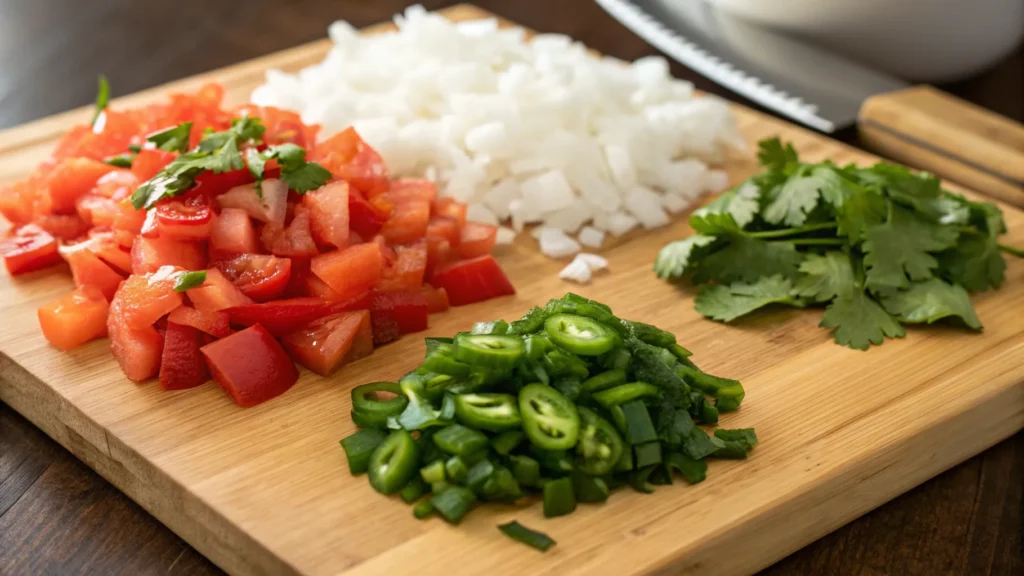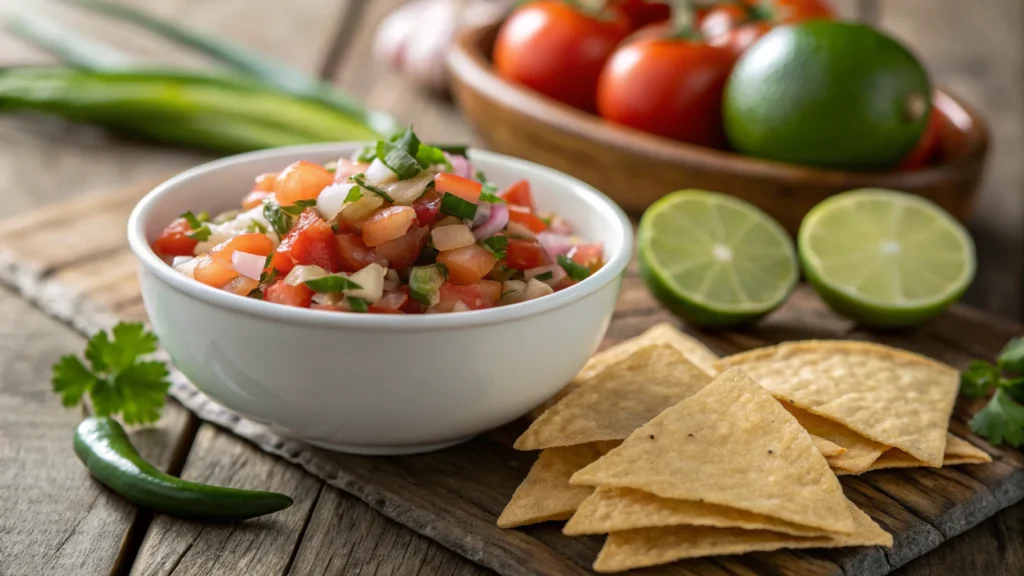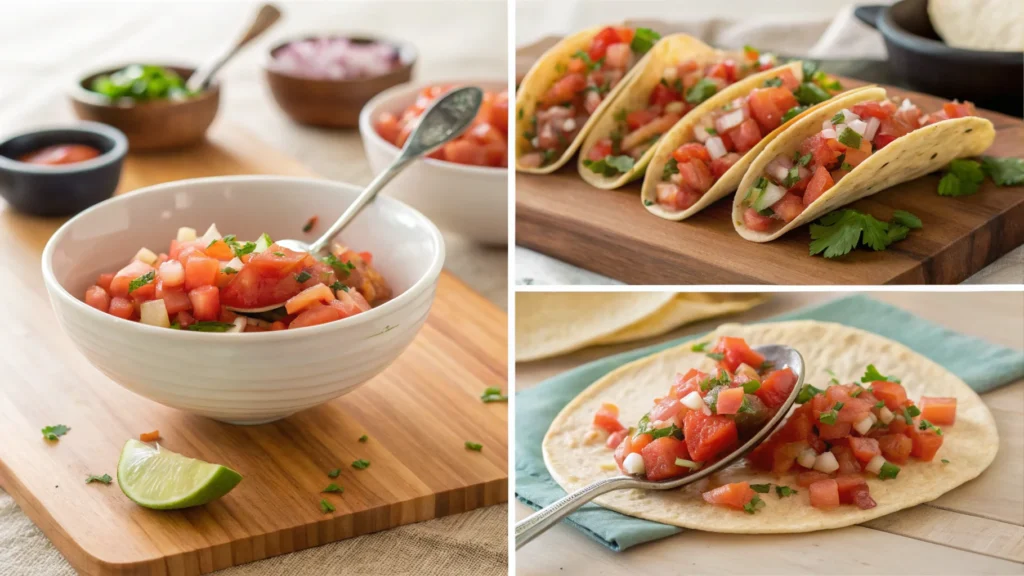Pico de gallo is a staple in Mexican cuisine, known for its fresh, zesty flavor and simple ingredients. Whether you’re making tacos, burritos, or grilled meats, this chunky salsa adds a burst of freshness to any dish.
In this guide, we’ll break down the best pico de gallo recipe, covering everything from choosing the right ingredients to serving suggestions and storage tips. You’ll also learn about variations, common mistakes, and the health benefits of this delicious condiment.
Table of contents
- What is Pico de Gallo?
- Ingredients for the Best Pico de Gallo
- Step-by-Step Guide to Making Pico de Gallo
- Variations of Pico de Gallo
- How to Serve Pico de Gallo
- Storing and Preserving Pico de Gallo
- Health Benefits of Pico de Gallo
- FAQs About Pico de Gallo
- Conclusion – Why You Should Make Homemade Pico de Gallo
What is Pico de Gallo?
Pico de gallo is more than just a salsa—it’s a versatile Mexican condiment that brings a fresh, crunchy texture to any meal. But what exactly is it, and how is it different from other salsas? Let’s find out.
A Classic Mexican Condiment
Pico de gallo, also known as salsa fresca, is a raw, chunky salsa made from diced tomatoes, onions, cilantro, lime juice, and chili peppers. Unlike smooth, blended salsas, it keeps its distinct texture, making it a go-to topping for tacos, grilled meats, and even eggs.
This vibrant mix is a staple in Mexican kitchens, often served as a side dish or dip with tortilla chips. Because of its simple ingredients, it’s incredibly easy to make at home—no fancy equipment required!
Pico de Gallo vs. Salsa: What’s the Difference?
Many people confuse pico de gallo with traditional salsa, but they’re not quite the same:
- Texture: Salsas are often blended or pureed, while pico de gallo is chunky and fresh.
- Water Content: Pico de gallo contains less liquid, making it great for dishes where you don’t want extra moisture.
- Taste Profile: Because it’s made from raw ingredients, pico de gallo has a bright, crisp flavor, while cooked salsas offer a deeper, roasted taste.
Why It’s Called Pico de Gallo
The name pico de gallo translates to “rooster’s beak” in Spanish. But why? Some believe it’s because people once ate it with their fingers, mimicking a rooster pecking at food. Others suggest the name comes from the sharp, spicy “bite” of the chilies. Either way, one thing’s for sure—this salsa is packed with flavor!

Ingredients for the Best Pico de Gallo
A great pico de gallo recipe starts with fresh, high-quality ingredients. Since this salsa isn’t cooked, every element shines—so choosing the right ones is key! Let’s break down what you’ll need.
Essential Ingredients & Their Roles
To make the best pico de gallo, you only need a handful of simple, fresh ingredients:
- Tomatoes – The heart of the dish. Choose ripe, firm tomatoes for the best texture and flavor.
- Onions – Adds a bold, slightly spicy bite. White onions are traditional, but red onions give a mild, sweeter taste.
- Cilantro – Brings a fresh, citrusy kick. Love it or hate it, it’s a must for authentic flavor.
- Jalapeños or Serrano Peppers – Adds heat and depth. Jalapeños offer mild spice, while serranos are hotter.
- Lime Juice – Balances the flavors with zesty acidity and keeps ingredients fresh.
- Salt – Enhances every flavor and helps draw out moisture for better marination.
Choosing the Best Tomatoes for Pico de Gallo
Not all tomatoes are equal! Since tomatoes are the base, picking the right variety makes a difference.
- Roma tomatoes – The top choice! They’re firm, less watery, and pack rich flavor.
- Cherry tomatoes – Give a sweet, juicy burst, perfect for a twist on classic pico de gallo.
The Secret to the Perfect Onion-Tomato Ratio
Balancing onions and tomatoes is crucial. Too much onion? Overpowering. Too little? Lacks depth. A good rule of thumb is a 2:1 tomato-to-onion ratio, ensuring a balanced flavor in every bite.
Step-by-Step Guide to Making Pico de Gallo
Making pico de gallo is incredibly simple, but a few techniques ensure it turns out perfect every time.
How to Chop Ingredients for Maximum Flavor
The way you chop your ingredients impacts the final taste and texture. Here’s how to do it right:
- Dice tomatoes evenly – Large chunks make it hard to scoop, while tiny pieces turn it mushy.
- Mince onions finely – They should blend into the mix rather than overpower it.
- Chop cilantro delicately – Avoid bruising it; a light chop keeps it fresh.
- Dice jalapeños small – Unless you want a spicy surprise, keep them finely chopped.
Mixing and Marinating for the Best Taste
Once everything is chopped, mix the ingredients in a bowl, then let it sit for 15–30 minutes. This allows the flavors to blend, creating a richer, more vibrant taste.
💡 Pro Tip: For an even better pico de gallo recipe, refrigerate it for an hour before serving. The flavors will intensify!
Common Mistakes to Avoid
Even a simple recipe has pitfalls. Here’s what to watch out for:
- Using overripe tomatoes – Too much liquid makes it soggy.
- Skipping the salt – Salt is essential; it draws out moisture, balancing the texture.
- Not letting it rest – Instant serving means flavors won’t blend well.

Variations of Pico de Gallo
One of the best things about a pico de gallo recipe is its versatility. While the classic version is perfect, experimenting with different ingredients can give it a unique twist.
Spicy Pico de Gallo: Adding Heat the Right Way
Want to crank up the heat? There are several ways to make your pico de gallo spicier:
- Swap jalapeños for serrano peppers—they pack twice the heat.
- Add a pinch of cayenne pepper or red pepper flakes.
- Include some diced habanero for a serious spice kick.
💡 Pro Tip: Remove the seeds and membranes of peppers to control the heat level.
Fruit-Based Pico de Gallo Variations
For a sweet and tangy twist, try fruit-infused versions:
- Mango pico de gallo – A tropical mix of mango, red onion, cilantro, and lime.
- Pineapple pico de gallo – Perfect with grilled chicken or seafood.
- Watermelon pico de gallo – A refreshing summer option.
Low-Sodium and No-Onion Alternatives
If you need a low-sodium or onion-free version:
- Use green onions for a milder taste.
- Swap onions for radishes or bell peppers for crunch.

How to Serve Pico de Gallo
Pico de gallo is more than just a dip—it’s a game-changer for countless dishes! Here’s how you can use it beyond tortilla chips.
Best Dishes to Pair with Pico de Gallo
This vibrant salsa pairs perfectly with:
- Tacos & Burritos – The fresh acidity cuts through rich, savory flavors.
- Grilled Meats – Serve with chicken, beef, or shrimp for extra zest.
- Eggs & Breakfast Dishes – Top over scrambled eggs or avocado toast for a fresh kick.
Creative Ways to Use Pico de Gallo Beyond Tacos
Thinking outside the box? Try these unexpected ways to enjoy it:
- Mix into guacamole for an extra chunky texture.
- Use as a burger topping instead of ketchup.
- Toss with pasta or rice for a Mexican-style salad.
Storing and Preserving Pico de Gallo
Once you’ve made the perfect pico de gallo recipe, you might wonder how to keep it fresh. Since it’s made with raw ingredients, proper storage is key to maintaining its flavor and texture.
How Long Does Pico de Gallo Last?
Freshly made pico de gallo is best enjoyed the same day, but it can last up to 3 days in the fridge. However, as it sits, the tomatoes release water, making it softer and less crunchy.
💡 Pro Tip: If your pico de gallo becomes watery, simply drain the excess liquid before serving.
Best Containers for Storage
To keep it fresh longer, store pico de gallo in:
- Airtight glass containers – Helps maintain flavor and prevents odors.
- Plastic containers with tight lids – Convenient but may absorb smells over time.
Can You Freeze Pico de Gallo?
Technically, yes—but freezing changes the texture. Tomatoes turn mushy after thawing, so it’s best to enjoy pico de gallo fresh. If you must freeze it, use it as a base for soups or sauces rather than a dip.
Health Benefits of Pico de Gallo
A good pico de gallo recipe isn’t just delicious—it’s packed with nutrients and offers several health benefits.
Low-Calorie and Nutrient-Dense Benefits
Pico de gallo is naturally low in calories but rich in vitamins and antioxidants:
- Tomatoes – Loaded with vitamin C and lycopene, which help support the immune system.
- Onions & Garlic – Contain anti-inflammatory properties and may boost heart health.
- Cilantro & Lime – Help with digestion and add essential nutrients like vitamin K.
How Pico de Gallo Supports Digestive Health
Because it’s made from whole, fresh ingredients, pico de gallo is:
- High in fiber, aiding digestion.
- Low in sodium, making it a heart-friendly choice.
- Free of unhealthy additives, unlike store-bought salsas.
With its fresh, natural ingredients, pico de gallo is a healthy, guilt-free addition to any meal!
FAQs About Pico de Gallo
Many people have questions about making, storing, and tweaking a pico de gallo recipe. Here are some common ones!
Why Does My Pico de Gallo Taste Bland?
If your pico de gallo lacks flavor, here’s how to fix it:
- Use ripe tomatoes – Unripe ones lack sweetness and depth.
- Let it rest – Flavors blend better after 15–30 minutes.
- Add more lime juice and salt – These enhance all the ingredients.
Can I Make Pico de Gallo Ahead of Time?
Yes! You can make pico de gallo a day in advance, but it’s best when fresh. If making ahead:
- Store it in an airtight container to prevent excess moisture.
- Drain extra liquid before serving for the best texture.
- Give it a quick stir to refresh the flavors.
What Are the Best Substitutes for Cilantro in Pico de Gallo?
Not a fan of cilantro? No problem! Try these alternatives:
- Parsley – Similar color with a milder taste.
- Basil – Adds a sweet, slightly peppery flavor.
- Green onions – Provide freshness without overpowering.
If you love fresh and flavorful dishes, you might also enjoy trying Ground Chicken Mexican Corn Recipe. This delicious and easy-to-make recipe pairs perfectly with pico de gallo, making it a great choice for a Mexican-inspired meal! 🌮🔥
Conclusion – Why You Should Make Homemade Pico de Gallo
Making pico de gallo at home is a simple and rewarding way to add fresh, vibrant flavors to your meals. With just a handful of ingredients, you can create a delicious, versatile condiment that enhances everything from tacos and burritos to grilled meats and breakfast dishes. Unlike store-bought versions, homemade pico de gallo is free from preservatives and artificial additives, allowing you to enjoy pure, authentic taste with every bite.
For another delicious and fresh recipe, check out this Cucumber Salad with Smoked Salmon. It’s a light, refreshing dish that pairs wonderfully with pico de gallo for a balanced and flavorful meal.
So, grab your tomatoes, onions, and lime, and start making the best homemade pico de gallo today!

